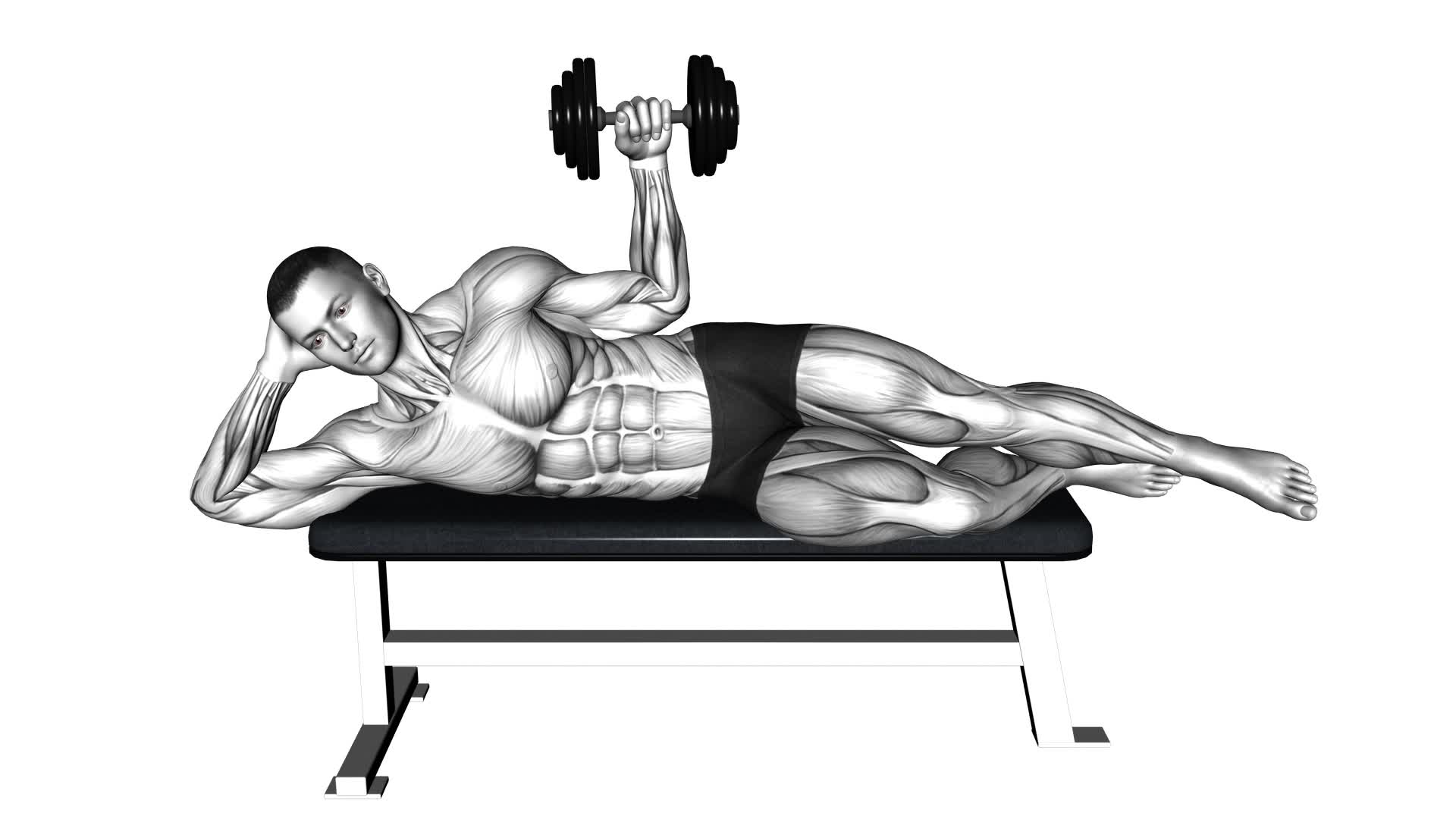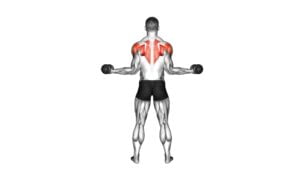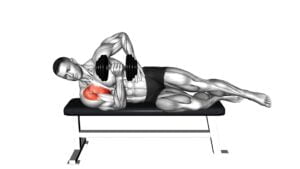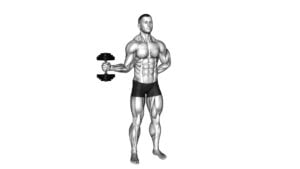Dumbbell Side Lying External Rotation (On a Bench) (Male) – Video Exercise Guide & Tips

Looking to strengthen your shoulder muscles? This video exercise guide and tips will walk you through the proper technique for performing the dumbbell side lying external rotation on a bench.
Watch This Exercise Video
With just a pair of dumbbells and a bench, you can target your shoulders effectively. Avoid common mistakes and learn how to progress and vary the exercise for maximum results.
Get ready to feel the burn and improve your shoulder strength with this informative guide.
Key Takeaways
- Dumbbell side lying external rotation improves shoulder stability and mobility.
- This exercise targets the rotator cuff muscles and reduces the risk of injuries.
- Working both sides equally helps maintain balance, symmetry, and reduces muscle imbalances.
- Progression and variation can be achieved by increasing weight gradually, trying different angles, and adding resistance bands.
Benefits of Dumbbell Side Lying External Rotation
You can gain shoulder stability and strengthen your rotator cuff muscles with the dumbbell side lying external rotation exercise. This exercise offers several benefits for your shoulder mobility and overall upper body strength.
One of the key benefits is improved shoulder stability. By targeting the rotator cuff muscles, this exercise helps to stabilize the shoulder joint, reducing the risk of injuries and improving overall shoulder function.
Another benefit of the dumbbell side lying external rotation is increased shoulder mobility. This exercise specifically targets the external rotators of the shoulder, which are responsible for rotating the arm outwards. By strengthening these muscles, you can improve your range of motion and flexibility in the shoulder joint.
Moreover, proper form is of utmost importance when performing this exercise. It's crucial to maintain a neutral spine and engage the core muscles throughout the movement. This not only ensures that you're targeting the intended muscles but also helps in preventing any strain or injury to the back.
Equipment Needed for the Exercise
To perform the dumbbell side lying external rotation exercise, you'll need a bench and a pair of dumbbells. The bench should be sturdy and stable, providing a comfortable surface for you to lie on. Make sure it's at a height that allows your shoulder to be in a neutral position when performing the exercise. The dumbbells should be of an appropriate weight for your fitness level and goals.
If you don't have access to a bench, there are alternative exercises you can do for external shoulder rotation. One option is the standing external rotation exercise, where you hold a dumbbell in one hand and lift it out to the side, keeping your elbow bent at a 90-degree angle.
Another alternative is the cable external rotation exercise, where you attach a resistance band or cable to a low pulley and perform the rotation movement.
For individuals with shoulder injuries or limitations, modifications can be made to the exercise. It's important to consult with a healthcare professional or qualified trainer before attempting any exercise if you have an injury. They can provide guidance on modifications that will allow you to safely work the muscles involved in external shoulder rotation without exacerbating your injury. This may include using lighter weights, performing the exercise with your arm supported, or using resistance bands instead of dumbbells.
Proper Set-Up and Positioning on the Bench
To properly set up and position yourself on the bench for the dumbbell side lying external rotation exercise, always position the bench at a height that allows for a neutral shoulder position. This ensures proper alignment and reduces the risk of injury. Here are some key points to consider when positioning yourself on the bench:
- Sit on the edge of the bench with your feet planted firmly on the ground.
- Lean to one side and position your body parallel to the bench.
- Extend your legs out straight and place your bottom arm perpendicular to your body to provide stability.
- Keep your head and neck in a neutral position, aligned with your spine.
- Hold the dumbbell in your top hand, with your elbow bent at a 90-degree angle.
By following these guidelines, you'll create a solid foundation for performing the dumbbell side lying external rotation exercise effectively and safely.
Now that you have set up and positioned yourself correctly on the bench, it's time to move on to the step-by-step guide for performing the exercise.
Step-by-Step Guide for Performing the Exercise
Now that you have positioned yourself correctly on the bench, let's delve into the step-by-step guide for performing the dumbbell side lying external rotation exercise. This exercise primarily targets the rotator cuff muscles and helps improve shoulder stability and strength.
- Start by lying on your side on a bench with your knees slightly bent. Hold a dumbbell in your top hand, with your elbow bent at a 90-degree angle.
- Keep your upper arm against your side and your forearm perpendicular to the floor. This is your starting position.
- Slowly rotate your forearm away from your body, while keeping your elbow against your side. Exhale as you perform this movement.
- Pause for a moment at the top of the movement and squeeze your shoulder blade.
- Inhale as you slowly lower the dumbbell back to the starting position.
For beginners, it's important to focus on proper form and technique rather than using heavy weights. Start with lighter dumbbells and gradually increase the weight as you become comfortable with the exercise.
To optimize results, aim for 2-3 sets of 10-12 repetitions per side. Remember to rest for 30-60 seconds between sets. As you progress, you can increase the intensity by using heavier dumbbells or adding more sets.
Common Mistakes to Avoid
Now, let's explore some common mistakes to avoid when performing the dumbbell side lying external rotation exercise on a bench.
It's important to pay attention to your form to ensure you're getting the most out of this exercise and avoiding any potential injuries. Here are some common mistakes to watch out for:
- Using too much weight: One of the most common mistakes is using weights that are too heavy. This can lead to improper form and increase the risk of injury. Start with lighter weights and gradually increase as you build strength.
- Not keeping your shoulder stabilized: Proper form requires keeping your shoulder stabilized throughout the exercise. Avoid letting your shoulder roll forward or backward, as this can put unnecessary strain on the joint.
- Raising your elbow too high: When performing the external rotation, it's important to keep your elbow at a 90-degree angle. Avoid raising your elbow too high, as this can shift the focus away from the targeted muscles.
- Rushing through the exercise: Take your time and focus on the movement. Rushing through the exercise can lead to sloppy form and decreased effectiveness. Maintain control throughout the entire range of motion.
- Neglecting the opposite side: It's important to work both sides of your body equally. Neglecting one side can create imbalances and increase the risk of injury. Make sure to perform the exercise on both sides with equal effort.
Tips for Progression and Variation
To progress in this exercise, you can start by increasing the weight of the dumbbell gradually. This will challenge your muscles and help you build strength over time.
Another way to vary the exercise is by trying different angles. By changing the angle of your arm, you can target different muscles in your shoulder.
Lastly, you can add resistance bands to increase the difficulty of the exercise and further challenge your muscles.
Increasing Weight Gradually
Start by gradually increasing the weight you use for the dumbbell side lying external rotation exercise. Progressive overload is key to improving your strength and muscle development. Here are some tips for effectively increasing the weight:
- Start with a weight that challenges you, but still allows you to maintain proper form.
- Increase the weight by small increments, such as 2-5 pounds, to ensure a gradual progression.
- Listen to your body and only increase the weight when you feel comfortable and confident.
- Aim to increase the weight every 1-2 weeks to continually challenge your muscles.
- Keep track of your progress by recording the weights used and the number of repetitions performed.
Trying Different Angles
As you explore different angles for the dumbbell side lying external rotation exercise, you can add progression and variation to your training routine. Trying different angles not only helps in improving shoulder mobility but also allows you to modify the exercise intensity. By adjusting the angle of your arm, you can target different muscles in your shoulder complex.
For example, performing the exercise with your arm at a 45-degree angle will emphasize the external rotators, while a 90-degree angle will engage the middle deltoid. To increase the challenge, you can also try performing the exercise on an incline bench or using a heavier dumbbell.
Remember to start with lighter weights and gradually increase the intensity as you become more comfortable and confident in your form.
Adding Resistance Bands
As you explore different angles for the dumbbell side lying external rotation exercise, you can enhance progression and variation by incorporating resistance bands.
Resistance band exercises offer numerous benefits, such as increased muscle activation, improved stability, and added resistance throughout the entire range of motion.
Here are five tips to help you incorporate resistance bands into your side lying external rotation routine:
- Start with a light resistance band and gradually increase the tension as you become more comfortable with the exercise.
- Attach the resistance band to a stable anchor point, such as a squat rack or sturdy furniture, to ensure proper resistance throughout the movement.
- Place the resistance band around your wrist and hold onto the dumbbell for added resistance and stability.
- Aim to maintain proper form throughout the exercise, keeping your shoulder blades down and back, and your core engaged.
- Experiment with different resistance band tensions and positions to target different muscles and challenge yourself further.
Frequently Asked Questions
How Many Repetitions and Sets Should I Perform for the Dumbbell Side Lying External Rotation Exercise?
To get the most out of the dumbbell side lying external rotation exercise, it's important to know how many repetitions and sets to perform.
For optimal results, aim for 2-3 sets of 10-15 repetitions on each side.
This will help strengthen your rotator cuff muscles and improve shoulder stability.
Remember to start with a weight that challenges you but still allows for proper form.
Avoid common mistakes like using momentum or lifting too heavy, as this can lead to injury.
Can I Use Resistance Bands Instead of Dumbbells for This Exercise?
Yes, you can definitely use resistance bands instead of dumbbells for the side lying external rotation exercise. Using resistance bands offers several benefits for this exercise.
They provide constant tension throughout the movement, helping to engage the muscles effectively.
Resistance bands also allow for a wider range of motion, making the exercise more challenging.
Additionally, resistance bands are portable and versatile, making them a convenient option for home workouts or on-the-go training.
Is It Necessary to Warm up Before Performing the Dumbbell Side Lying External Rotation Exercise?
Before starting any strength training exercise, it's always beneficial to warm up your muscles. Incorporating warm-up exercises can help increase blood flow, improve flexibility, and reduce the risk of injury.
When performing the dumbbell side lying external rotation exercise, it's important to focus on proper form and technique. This exercise targets the muscles of the shoulders and rotator cuff, so maintaining good alignment and control is key.
Remember to start with lighter weights and gradually increase as you become more comfortable and confident in your technique.
What Are Some Alternative Exercises That Target the Same Muscles as the Dumbbell Side Lying External Rotation?
Looking for alternative exercises that target the same muscles as the dumbbell side lying external rotation?
Well, cable external rotations and prone external rotations are great options.
Cable external rotations involve using a cable machine to work your shoulder muscles, while prone external rotations involve lying face-down and rotating your arm outward.
Both exercises effectively target the same muscles as the dumbbell side lying external rotation, providing a variety of options for your workout routine.
Should I Feel Any Pain or Discomfort During or After Performing This Exercise?
You shouldn't feel any pain or discomfort during or after performing this exercise. However, it's important to maintain proper form and technique to prevent injury.
To do the dumbbell side lying external rotation correctly, follow these steps:
- Lie on your side on a bench with your elbow bent at a 90-degree angle and your upper arm resting on the bench.
- Rotate your forearm upward, keeping your elbow in contact with the bench.
- Avoid the common mistake of using excessive weight, which can strain your shoulder.
Remember to start with a weight that you can comfortably handle and gradually increase it as you become stronger.
Conclusion
In conclusion, the dumbbell side lying external rotation exercise is a beneficial way to strengthen the shoulder muscles. By using a bench and proper positioning, you can effectively perform this exercise.
Be sure to avoid common mistakes and follow the step-by-step guide for optimal results. With progression and variation, you can continue to challenge and improve your shoulder strength.
Incorporate this exercise into your fitness routine to enhance your overall shoulder stability and function.

Author
Years ago, the spark of my life’s passion ignited in my mind the moment I stepped into the local gym for the first time. The inaugural bead of perspiration, the initial endeavor, the very first surge of endorphins, and a sense of pride that washed over me post-workout marked the beginning of my deep-seated interest in strength sports, fitness, and sports nutrition. This very curiosity blossomed rapidly into a profound fascination, propelling me to earn a Master’s degree in Physical Education from the Academy of Physical Education in Krakow, followed by a Sports Manager diploma from the Jagiellonian University. My journey of growth led me to gain more specialized qualifications, such as being a certified personal trainer with a focus on sports dietetics, a lifeguard, and an instructor for wellness and corrective gymnastics. Theoretical knowledge paired seamlessly with practical experience, reinforcing my belief that the transformation of individuals under my guidance was also a reflection of my personal growth. This belief holds true even today. Each day, I strive to push the boundaries and explore new realms. These realms gently elevate me to greater heights. The unique combination of passion for my field and the continuous quest for growth fuels my drive to break new ground.







